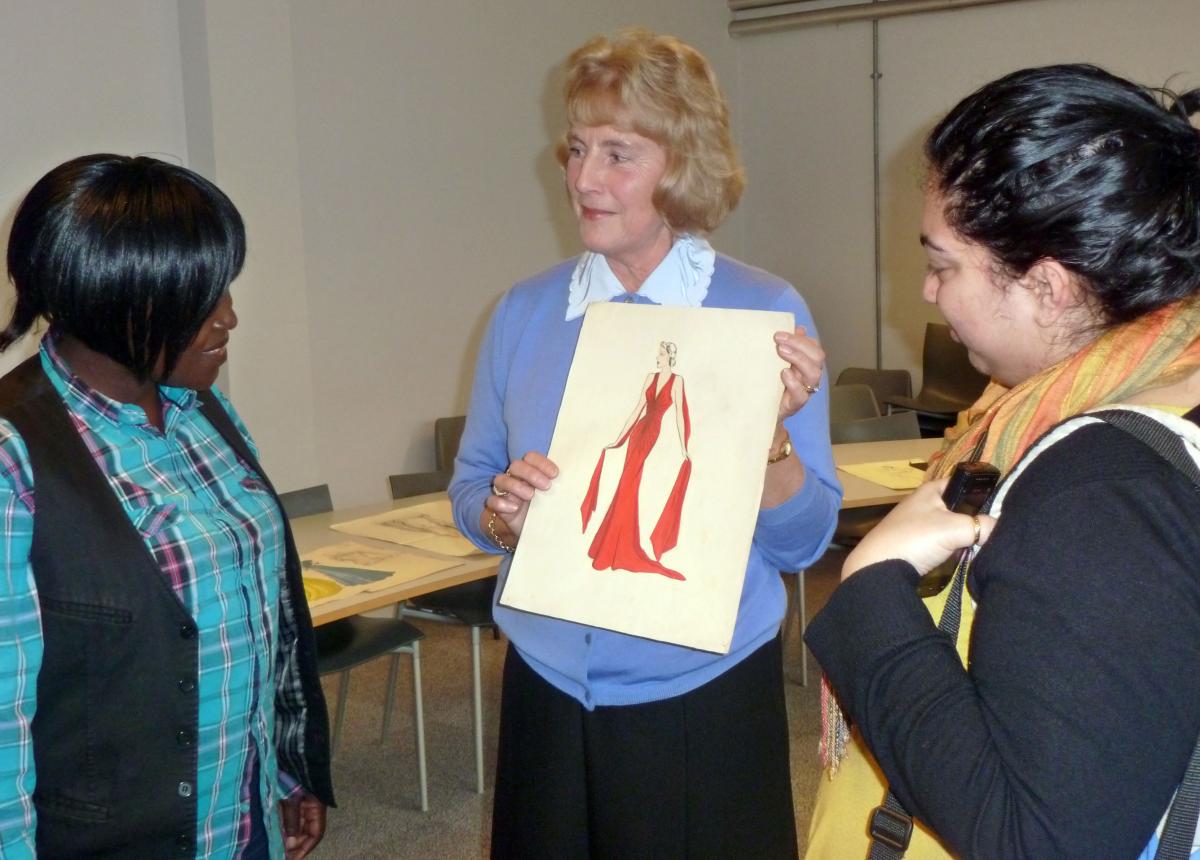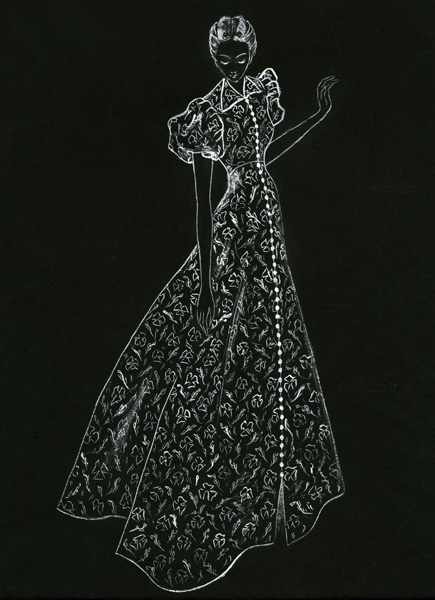
The hidden talents of an aspiring young fashion designer who studied at College during the 1930s came to light when her drawings were discovered hidden away in a drawer. Her daughter, Susan Mann visited College in 2010 to tell her mother's her remarkable story and show these fabulous designs to our BA (Hons) Fashion Design students.
Wendy explained, "I have come to share what I consider the biggest treasure I have at home - all my mother's work done over seventy years ago, which I was not aware of until six years ago. My mother is 93 now, but when she was in her eighties she was diasgnosed with vascular dementia and needed residential care. When I pack up her things I found the drawings and I was amazed by her reaction. Mother said she didn't ever want to see them again and I started trying to piece together her history.
 Irene was born in 1919, the middle daughter of a working class family. Her father was a bus conductor and all three girls were intelligent. They each passed the scholarship to attend grammar school but none went as their parents would not allow it. So they had a basic education at secondary school and leaving at sixteen, all became machinists. Wendy said, "My Mum , who was known as Rene, always wanted to be a fashion designer. She wanted to enrol at Bradford College of Art but had to wait until she was sixteen in 1935. The first thing she did was figure drawing, then working with live models, statues and plaques, before she was allowed to go on to fashion. Mum fought to go to Art School as her parents didn't approve. Their attitude was that girls were not meant to be educated and that they shouldn't rise above their station in life. Her sisters were jealous, especially the elder one who was very much a bully. Rene was frightened of her and the youngest sister was under her thumb. So she had barriers to study at home but Mum was very determined. From day one she had to hide her work at the bottom of a drawer."
Irene was born in 1919, the middle daughter of a working class family. Her father was a bus conductor and all three girls were intelligent. They each passed the scholarship to attend grammar school but none went as their parents would not allow it. So they had a basic education at secondary school and leaving at sixteen, all became machinists. Wendy said, "My Mum , who was known as Rene, always wanted to be a fashion designer. She wanted to enrol at Bradford College of Art but had to wait until she was sixteen in 1935. The first thing she did was figure drawing, then working with live models, statues and plaques, before she was allowed to go on to fashion. Mum fought to go to Art School as her parents didn't approve. Their attitude was that girls were not meant to be educated and that they shouldn't rise above their station in life. Her sisters were jealous, especially the elder one who was very much a bully. Rene was frightened of her and the youngest sister was under her thumb. So she had barriers to study at home but Mum was very determined. From day one she had to hide her work at the bottom of a drawer."
Rene was promoted to the cutting department while her sisters remained in machining. Rene met her husband at College and although he deterred her from continuing evening classes she continued, and compromised by having him walk her home. When she was 21 she married and gave up her classes. Her husband didn't want her going out to work but she was allowed her to dressmake at home. She had learned to make patterns and her sisters relied on her to expertise so they could make extra money from dressmaking with her unacknowledged input. She had three sons in quick succession and her husband joined the army. Susan recalled "Mum took me around all the habadeshery shops in Bradford collecting zips, buttons and trimmings. People came to her with pictures from magazines and material. Sometimes she had to be diplomatic but she always made sure her clients were well dressed." Rene stuck to a tight schedule despite having a home and family to care for. On Mondays she would begin new work and cut out. On Tuesday she got garments ready to for clients to try on that afternoon, and each garment was ready to collect on Friday. She still designed and made clothes but only for her own family. She never let disappointment make her bitter but was a devoted wife and mother.
 Susan continued, "Mum could remember the smell of the fabrics at College. She spent some of the happiest times of her life there." Although Rene's ambitions were crushed by social convention and fear of provoking her family, her drawings express a sense of achievement and creative freedom that she struggled so hard for." Rene showed the designs to vintage specialists Rose & Brown and they loved Rene's work so much that they featured it in a vintage fashion show in Saltaire. Her work was displayed and Susan had one of Rene's designs made up for her daughter to model. Rene was able to attend this and on better days has been able to look at the drawings. Susan said, "I take the drawings in to show her now and again. On her best days she felt the faces were like looking at family photographs. There is one that she particularly loves with white paint on black paper. She had done it freehand with a tiny brush. I had it framed but she wanted it taken down as she said it had to be a secret. It is so sad."
Susan continued, "Mum could remember the smell of the fabrics at College. She spent some of the happiest times of her life there." Although Rene's ambitions were crushed by social convention and fear of provoking her family, her drawings express a sense of achievement and creative freedom that she struggled so hard for." Rene showed the designs to vintage specialists Rose & Brown and they loved Rene's work so much that they featured it in a vintage fashion show in Saltaire. Her work was displayed and Susan had one of Rene's designs made up for her daughter to model. Rene was able to attend this and on better days has been able to look at the drawings. Susan said, "I take the drawings in to show her now and again. On her best days she felt the faces were like looking at family photographs. There is one that she particularly loves with white paint on black paper. She had done it freehand with a tiny brush. I had it framed but she wanted it taken down as she said it had to be a secret. It is so sad."
The orginal drawings are irreplacable to Susan and her family. We are grateful to Susan for allowing us to digitise these drawings for our collection so that Irene's designs are preserved and finally have the appreciative audience that they deserve.
You can see Irene's fashion designs here